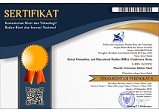Implementation of Ethnoscience Learning in Science and Social Learning to Elementary Students
Abstract
This research aims to describe the implementation of Ethnoscience learning in Science and Social Learning to elementary students, including the obstacles and the solutions as well as student learning outcomes. This research uses a qualitative approach with a descriptive type. The data used is the result of observation, interviews and documentation. The analysis was carried out by applying a descriptive qualitative interactive model approach. The research results show that 1) Implementation of Ethnoscience learning in Science and Social Learning is carried out by observing, identifying, preparing questions, discussing, completing assignments, and submitting assignment results. The learning process takes place in a way that students understand the lesson material in a real way and in accordance with everyday life; 2) The obstacle faced by teachers in learning is that the learning process takes a relatively long time or requires a lot of time. 3) To overcome these obstacles, teachers carry out supervisory and guidance functions during the learning process; and 4) The results of implementing Ethnoscience learning in Science and Social Learning are that student learning outcomes increase. The results of the research concluded that Ethnoscience learning is very appropriate to apply to Science and Social Learning because it is interrelated in terms of using the environment as learning resources.
Keywords
Full Text:
PDFRefbacks
- There are currently no refbacks.




